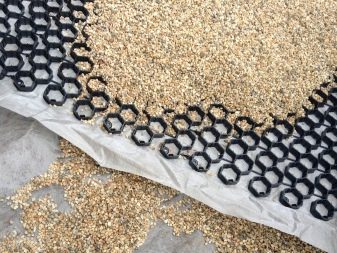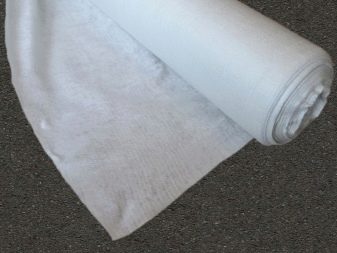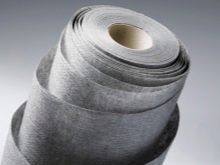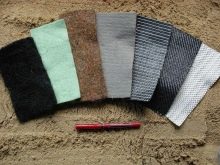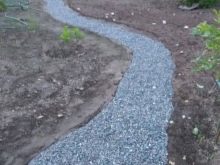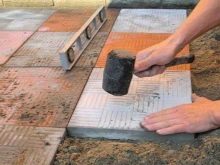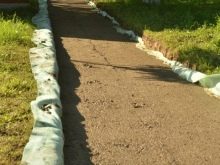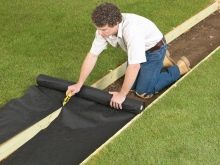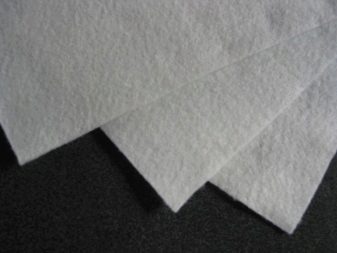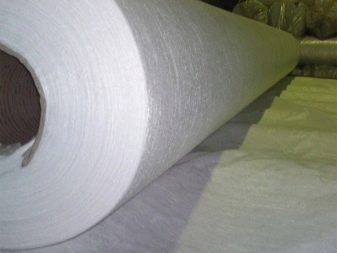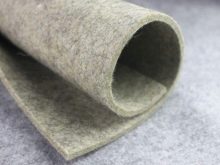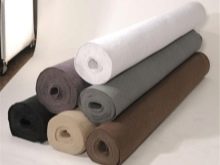Rules for the selection of geotextiles for garden paths
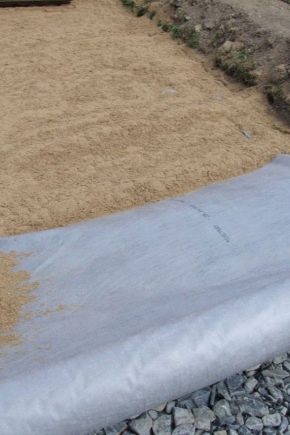
Arrangement of garden paths is an important part of the work on the landscaping of the site. Every year, manufacturers offer more and more different types of coatings and materials designed for this purpose. The article will discuss the currently popular material for garden paths - geotextiles.
Specifics
Geotextile (geofabric) is really in appearance in many respects similar to a fabric canvas. The material consists of a set of closely compressed synthetic threads and hairs. Geofabric, depending on what basis it is made, is of three kinds.
- Based on polyester. This type of canvas is quite sensitive to the effects of external natural factors, as well as alkalis and acids.Its composition is more environmentally friendly, but polyester geotextiles are less durable in use.
- Based on polypropylene. This material is more resistant, it is very durable. In addition, it is not exposed to mold and putrefactive bacteria, fungi, as it has the properties of filtration and removal of excess moisture.
- Based on several components. The composition of the canvas of this type includes a variety of recycled materials: used viscose or wool items, cotton materials. This option is the cheapest geotextile, but in terms of durability and strength, it is inferior to the other two types of canvas. Due to the fact that the material contains natural substances, multicomponent (blended) geofabric is easily destroyed.
Species
According to the type of fabric production, the material is divided into several groups.
- Needle punch. This material is able to pass water or moisture in the directions along and across the canvas. At the same time, contamination by soil and extensive flooding are excluded.
- "Doronit." This canvas has good reinforcing properties and a high degree of elasticity. Such geofabric can be used as a reinforcing base.The material has filtering properties.
- Thermofixed. This type of material has a very low filtration, since it is based on threads and fibers that are strongly fused with each other.
- Thermoprocessed. The basis of this canvas - fused and at the same time highly compressed fibers. Geofabric is very durable, but does not possess filtration properties at all.
- Building. Able to pass water and moisture from the inside to the outside. Most often used for steam and waterproofing.
- Knitting with stitching. The fibers in the material are bonded with synthetic threads. The material is able to pass moisture well, but at the same time it is relatively low-strength, poorly resistant to external influences.
Application at the site
Geotextiles fit into prepared trenches for tracks. It contributes to the strengthening of the path and prevents the subsidence of tiles, gravel, stone and other materials.
Consider the order of work.
- At the first stage, the contours and dimensions of the future path are laid out. According to the outlines, a 30-40 cm depression is dug out.
- At the bottom of the excavated trench is laid a small layer of sand, which should be well leveled.Then a geofabric is applied to the surface of the sand layer. The material should be placed in a trench so that the edges of the web go to the slopes of the recess approximately 5-10 cm.
- At the joints it is necessary to make an overlap of at least 15 cm. The material can be fastened with the help of a construction stapler or using the stapling method.
- Further, fine gravel is poured on the laid geotextile material. The layer of rubble should be 12-15 cm, it is also carefully leveled.
- Then another layer of geotextiles is laid. A layer of sand about 10 cm thick is poured over the canvas.
- On the last layer of sand is laid directly track cover: stones, tiles, gravel, pebbles, side trim.
Experts recommend to lay only one layer of geotextile, if the path is covered with a layer of pebbles or gravel. These materials do not have a large mass and do not contribute to the intensive subsidence of the entire structure.
Advantages and disadvantages
The advantages of the material include the following characteristics.
- Garden paths and paths between the beds are becoming more durable, resistant to blurring and destruction. They will be able to withstand much greater mechanical stress and load.
- The canvas prevents the growth of weeds through the cover of the track.
- Geofabric helps to strengthen the soil in areas of the slope.
- Depending on the properties of a particular type of web, it is possible to achieve moisture filtration, waterproofing, and drainage properties with the help of geofabric.
- Interferes with the sagging of the track, as the layers of sand and gravel are kept from settling into the ground.
- The canvas is able to maintain an optimal level of heat transfer in the soil.
- Rather simple and easy installation. You can even install the track yourself, without the involvement of specialists.
Not without its drawbacks.
- Geotextiles do not tolerate exposure to direct sunlight. This should be considered when storing material.
- High-strength types of fabric, for example, polypropylene geotextiles, have a relatively high cost. It can reach up to 100-120 rubles / m2.
Tips for choosing
- The most durable type of geotextile is a canvas made on the basis of propylene fibers.
- Material mixed with cotton, wool or other organic components wears out faster. In addition, this geofabric practically does not perform drainage functions.
- Geotextiles vary in density.Suitable for arranging tracks in the country is a canvas, the density of which is not less than 100 g / m2.
- If the site is located in an area with unstable soil, it is recommended to use geofabric with a density of 300 g / m3.
To avoid a lot of unnecessary cut material after the work, it is advisable to determine in advance the width of the tracks. This will allow you to select the roll of the desired size.
For information on which geotextiles to choose, see the video below.
